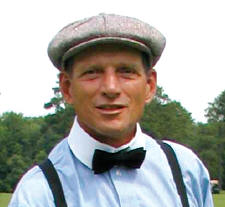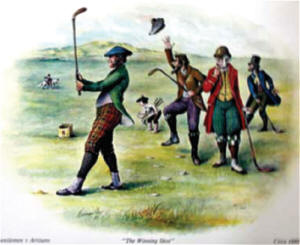A Whimsical Look at Why an 8,000-Yard Course Will Soon be a Standard
Many years back, in a little town by the sea, a game called gowf was played by a few of the local nobility. It was a simple enough game, requiring a sturdy four-and-a-half foot tree branch, with six inches bent at about a 45 degree angle on one end. The branch, when swung in a downward motion from shoulder height, would propel a round stone along the ground to a target in the distance. The person reaching the target in the fewest number of strikes was the winner. At first, the target was a tree or large
boulder, until one day, after considerable searching, Lord William McPark found his stone at the bottom of a rabbit hole. From then on, the object became to intentionally knock the stone into a pre-selected hole, meticulously dug to a depth from which the stone could be easily retrieved. The hole could be no larger than that made by the average rabbit. After all, what challenge is there in aiming one’s stone at a hole made by a sheep or goat?
Soon after, marker sticks became necessary and were placed in the target hole when, in a particularly close match, two shots played from about the same distance vanished into separate holes. The bewildered participants, unable to agree on who was entitled to the wager of two gold nuggets, went off to consult with the local magistrate. The official, being astute and wary of an uprising from those supporting the loser of his decision, disqualifies both and kept the nuggets as payment for calling the court into a special administrative session.
 From that point forward, sticks were placed in each hole to mark the official target at which to take aim. As the community prospered, more people took up the gowf, and soon the abundance of appropriate tree branches started to dwindle. Also, the stone balls were especially hard on the wood, as evidenced by the many splinters strewn across the fair meadow. About this time, one of the town’s carpenters began getting regular visits by locals requesting repairs to their favorite gowf sticks. Not knowing much about the game, the carpenter, a curious sort, learned that the nicks and gouges were caused by the stone balls, and sometimes clubs actually broke into pieces when one really struck a mighty blow.
From that point forward, sticks were placed in each hole to mark the official target at which to take aim. As the community prospered, more people took up the gowf, and soon the abundance of appropriate tree branches started to dwindle. Also, the stone balls were especially hard on the wood, as evidenced by the many splinters strewn across the fair meadow. About this time, one of the town’s carpenters began getting regular visits by locals requesting repairs to their favorite gowf sticks. Not knowing much about the game, the carpenter, a curious sort, learned that the nicks and gouges were caused by the stone balls, and sometimes clubs actually broke into pieces when one really struck a mighty blow.
Well, one fine day, in walked Andrew McMorris with a rather nasty gouge in his only club, and right before a big match with James Dunn. Now, McMorris had never beaten Dunn, who always seemed to hit his stone further and more accurate… but, with a defective club, any hope of victory was certainly dashed. The carpenter, having given considerable thought to the subject, knew that wood against stone was no match, but wood against wood made logical sense. He told McMorris that he could repair the club, but one good whack would probably result in its demise. McMorris was beside himself; however, the carpenter told him he might get through the match with his newly invented wood ball. Knowing it was his only chance to play, McMorris reluctantly agreed and headed to his match, resigned to the fact he would be thrashed and probably be the fodder of the gowfing community.
On the first tee, Dunn hit a wonderfully rolling shot straight down the middle, some 40 yards. McMorris stepped to the teeing ground, quickly placed the wood ball down, and before Dunn could protest, swung with his usual gusto. Not only did the ball travel twice as far at Dunn’s, it actually rose off the ground some three feet and floated across the meadow to a resting spot within reachable distance to the hole. Stunned silence engulfed the two men. Nary a word was exchanged the remainder of the day. Even though he shot his best score ever, Dunn was crushed. It might be the first time a gowfer lost every hole. It was the best day of McMorris’ life. Needless to say, Dunn’s first destination was to the carpenter’s shop, and the game of gowf was elevated to a new level. Shortly thereafter, demand for wooden golf balls was so great that the carpenter had to hire apprentices to keep up the supply. To compensate for the dwindling number of tree branches, and having good knowledge of wood joints and splices, the shop began making clubs in addition to balls, and soon the golf club business was booming.
 The new availability of clubs and balls meant more gowfers and competitions. The desire to beat one’s opponent had players constantly modifying equipment, searching for ways to make the ball go farther and more accurate. In addition to equipment, someone was always trying to improve the ball, believing the lighter it was the farther it would fly. Stuffing feathers inside of a leather pouch, as the Romans did in one of their games, would prove to be a great discovery. Molding rubber into a round sphere made the game even cheaper to play, and created a ball so durable that iron clubs could be forged by the local blacksmith to get over those nasty walls and out of the ruts left by carriage tires, something wood clubs would not do easily.
The new availability of clubs and balls meant more gowfers and competitions. The desire to beat one’s opponent had players constantly modifying equipment, searching for ways to make the ball go farther and more accurate. In addition to equipment, someone was always trying to improve the ball, believing the lighter it was the farther it would fly. Stuffing feathers inside of a leather pouch, as the Romans did in one of their games, would prove to be a great discovery. Molding rubber into a round sphere made the game even cheaper to play, and created a ball so durable that iron clubs could be forged by the local blacksmith to get over those nasty walls and out of the ruts left by carriage tires, something wood clubs would not do easily.
With each new innovation, more players jumped in and play improved. It was narcotic. The ball was traveling farther and farther. They made courses longer to compensate, but still the hunger for distance became ravenous. It certainly has become the opium of the golf masses. And, all this because one William McMorris outdrove his opponent by some 40 yards.
Mike Stevens is Southeast Director of the USGTF and golf teaching pro at MacDill Air Force Base in Tampa, Florida. He was the 2005 National Hickory Champion and the 2004 US Golf Teachers Senior Champion. In 2008 he finished second in the National Hickory and teamed with Mark Harman to win the Southern Hickory Four Ball. He also owns and operates the Mike Stevens On Target Golf School in Tampa and Sarasota.




